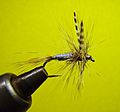Fly fishing facts for kids
Fly fishing is a fun way to catch fish. It uses a special lightweight fishing rod and line. Instead of a regular bait, you use a fake insect called an artificial fly. You cast this fly into the water to trick fish into biting.
People can catch many types of fish with fly fishing. This includes fish that live in freshwater, like rivers and lakes. You can also catch fish that live in the sea. Fly fishing uses special equipment like a fly-fishing rod, reel, and line. The flies are made from natural or man-made materials.
Contents
History of Fly Fishing
Fly fishing might have started a very long time ago in ancient Egypt. But the way we know it today began in England. This was in the late 1800s. Fishermen there first used real insects to catch fish. Later, they started using fake ones.
This new way of fishing became popular. It spread to other parts of Europe. Soon, people started having national and international competitions. These events helped more people learn about fly fishing.
Types of Fly Fishing
Fly fishing can be done in different places and ways. Each type uses slightly different methods.
Lake Fly Fishing
Lake fly fishing happens in calm waters. This includes reservoirs, ponds, and lakes. You can fish from the shore. Or, you can stand in the water, which is called fording. Sometimes, people use ships or boats to fish from the water.
River Fly Fishing
River fly fishing is usually done in moving water. Most of the time, people stand in the river itself. They wear special waders and wading boots to stay dry. Fishing from the river bank is also possible, but it's not as common.
Sea Fly Fishing
Sea fly fishing is done in the ocean. Just like river fishing, you can stand in the shallow water. This is also called fording. You can also fish from a boat out in the deeper water.
Dry Fly Fishing
In dry fly fishing, the special line floats on top of the water. The bait, or fly, also floats on the surface. These flies often look like insects that have just hatched. They can also look like other food that floats on the water.
Wet Fly Fishing
Wet fly fishing uses different types of fly-fishing lines. In this method, the fly goes under the water. The fly looks like drowned insects. It can also look like insects that are just hatching underwater.
Streamer Fishing
Streamer fishing often uses lines that sink. The flies used for this look like bigger insects. They can also look like small fish or other organisms that live in the water.
Nymph Fishing
Nymph fishing can be done with all kinds of fly-fishing lines. The flies used here look like young insects. These young insects, called nymphs, live underwater before they grow wings.
Fly Fishing Equipment
Fly fishing needs special tools. These tools help you cast the tiny fly far away.
Fly-Fishing Rod
A fly-fishing rod is a special kind of fishing rod. It is made only for fly fishing. Its main job is to give power to the fly-fishing line. This power helps carry the light artificial fly to where the fish are.
Fly-Fishing Line
The fly-fishing line is what moves the artificial fly. It helps the fly reach the casting spot. This line is only for fly fishing. It works with a fly-fishing rod and reel. Using it for other types of fishing could damage it.
Fly-Fishing Reel
The fly-fishing reel holds the fly-fishing line. The line is wrapped around a round part called a coil. This coil spins around its center. You reel in the line by turning a handle. The reel keeps the line neat and ready to use.
Images for kids
-
Fly rod and reel with a brown trout from a chalk stream in England
-
Izaak Walton's The Compleat Angler, published in 1653 helped popularize fly fishing as a sport. Woodcut by Louis Rhead, 1900
-
Fishing became a popular recreational activity in the 19th century. Print from Currier and Ives.
-
Frontispiece from The Art of Angling by Richard Brookes, 1790
-
Fly angler on the Firehole River, USA
-
Fly fishing on the Gardner River in Yellowstone National Park, USA
-
A rainbow trout taken on an articulated leech pattern, Bristol Bay Region, Alaska
-
"No Barbs" sign on Ribnik river in Bosnia
See also
 In Spanish: Pesca con mosca para niños
In Spanish: Pesca con mosca para niños




















